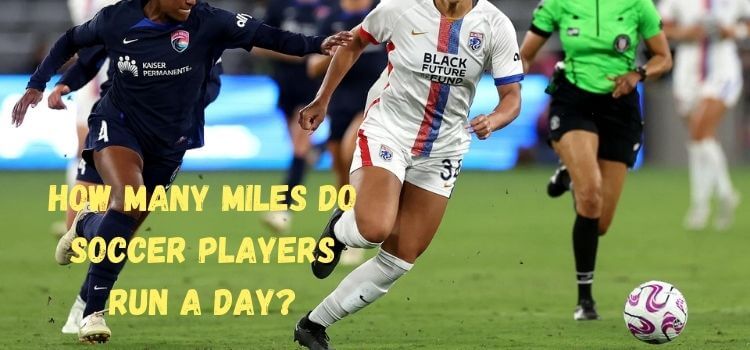As an Amazon Associate, I earn from qualifying purchases
Have they ever wondered about the incredible physical endurance required of soccer players? “How many miles do soccer players run a day?” is a common question among enthusiasts and curious minds alike.
Understanding the rigorous training regimens and demanding matches shed light on the astounding athleticism exhibited on the pitch. From professional leagues to grassroots levels, the distance covered by soccer players daily is a testament to their unparalleled fitness and dedication to the sport.
Let’s delve deeper into the fascinating world of soccer and explore the distances these athletes traverse during their daily routines.

Importance of Physical Fitness in Soccer
Physical fitness plays a paramount role in soccer performance. Endurance, agility, and speed are crucial attributes that enable players to sustain high-intensity activities throughout the game.
Due to the rigors of soccer, athletes must be in peak physical condition to contend with dynamic and unpredictable matches.
Factors Influencing Distance Covered
Several factors contribute to the distance covered by soccer players during a match. These include individual fitness levels, playing style, tactical approach, and environmental conditions.
Additionally, the player’s position on the field influences their running patterns and overall mileage.
Training Regimen
Professional soccer players undergo rigorous training regimens to enhance their physical capabilities. These include endurance drills, interval training, and strength conditioning exercises aimed at improving cardiovascular fitness and muscle strength.
Match Duration and Playing Position
A soccer match typically lasts 90 to 120 minutes, including injury and stoppage time. Players in different positions, such as midfielders, forwards, and defenders, have varying running requirements based on their roles and responsibilities on the field.
Professional Soccer Players’ Statistics
Statistics indicate that professional soccer players cover significant distances during a match. On average, soccer players may run anywhere between 7 to 9 miles per game, depending on several factors such as playing style, team tactics, and individual fitness levels.
Comparison with Other Sports
Soccer ranks among the top sports in terms of physical demands. Its continuous running, sprinting, and abrupt changes in direction make it comparable to endurance sports like long-distance running and cycling.
Strategies to Increase Mileage
Coaches and fitness experts employ various strategies to increase the mileage covered by soccer players. These include interval training, plyometrics, and specific drills focusing on acceleration and deceleration.
Importance of Rest and Recovery
In addition to training, adequate rest and recovery are essential for soccer players to avoid fatigue and injury. Proper sleep, nutrition, and hydration play crucial roles in facilitating muscle repair and optimizing performance.
Nutrition and Hydration
Soccer players must consume adequate nutrition and remain hydrated on a daily basis. Carbohydrates provide the necessary energy for endurance, while hydration ensures optimal bodily function and prevents dehydration during intense physical exertion.
Technological Advancements
Advances in sports science and technology have revolutionized soccer training and performance monitoring. Wearable devices, GPS tracking systems, and data analytics tools allow coaches to gather real-time insights into players’ physical exertion and tailor training programs accordingly.
The Future of Soccer Fitness
As technology continues to evolve, the future of soccer fitness holds promise for innovative training methodologies and personalized approaches to player development.
Virtual reality simulations, biofeedback training, and genetic profiling may redefine the boundaries of athletic performance in the coming years.
Case Studies
Examining the training routines of renowned soccer players offers valuable insights into their commitment to physical fitness.
From Cristiano Ronaldo’s legendary work ethic to Lionel Messi’s agility drills, each player’s regimen reflects their dedication to excellence on the field.
Tips for Amateur Players
Consistency is vital for amateur soccer enthusiasts looking to improve their endurance. Incorporating regular aerobic exercise, strength training, and flexibility exercises into their routine can gradually enhance their physical capabilities and overall performance on the field.
Conclusion: Miles Soccer Players Run
In conclusion, soccer players’ daily mileage is influenced by a myriad of factors, including individual fitness, playing position, and match dynamics. Sport athletes can improve their performance and excel in the beautiful game of soccer with disciplined training, proper nutrition, and technological innovations.
Unique FAQs
Soccer players maintain their energy levels through a combination of proper nutrition, hydration, and strategic rest intervals during the game.
Yes, soccer players often run more during intense phases of the match, such as when pressing for a goal or defending against an opponent’s attack.
Yes, there are various drills focused on improving endurance for soccer players, including interval training, shuttle runs, and high-intensity interval circuits.
To prevent fatigue and injury, soccer players must recover from training and competition to allow their muscles to recover.
Technological advancements such as GPS tracking systems and data analytics help coaches monitor players’ performance, identify areas for improvement, and tailor training programs to individual needs.
Read Our More Articles
- Why Do Soccer Players Raise Their Hands: Unraveling the Mystery
- Why Do Soccer Players Take Off Their Shirts? A Closer Look
- What are The Chances of Becoming a Professional Soccer Player?
As an Amazon Associate, I earn from qualifying purchases


